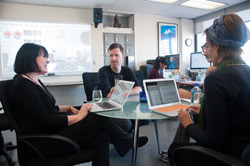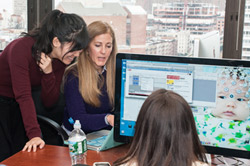A Framework for Doing Their Own Thing
What makes TC's Neurocognition of Language Lab truly special is a diverse group of students, with a wide range of perspectives and experience
The Power of Song: Dayna Moya
It’s no accident that singing is a near-universal activity for very young schoolchildren around the world. Studies have shown that just 21 minutes of exposure to music can increase children’s skill in detecting new language – in part by prompting their innate ability to calculate “transitional probability,” or the likelihood that one sound will fall next to another.
“That’s how we know when one word stops and another starts,” says Dayna Moya, a Ph.D. student in speech/language pathology who came to TC from Chile on a Fulbright Scholarship and now is supported by a Becas-Chile grant.
Moya, a former early childhood education teacher, suspects that when speech is paired with music, the musical tones can enhance that predictive skill. Intrigued by the possibilities of harnessing music’s power to improve second language acquisition as well, she is working on a study to test the language impact of exposure to music in seven-minute increments. “If we knew better how this complex process works, helping the learning process of the new language through music, we could develop more efficient strategies in schools to help children from all places to learn a second language.”
Seeing Dyslexia Differently: Lisa Levinson
Why do some individuals with dyslexia grow up to thrive in a literate world while others are more or less permanently derailed by the disorder?
Ph.D. student Lisa Levinson believes that children who receive explicit reading instruction and whose natural curiosity leads them to pick up books have better odds of one day becoming fluent readers. But what about the nature side of the equation?
All people with dyslexia share a difficulty in some aspects of what’s called phonological processing – for example, connecting phonemes, which are distinct units of linguistic sound, with graphemes, the written, symbolic representation of those sounds. Levinson believes the key to helping children who struggle with reading is to understand the neural mechanisms that support reading. Using EEG to “eavesdrop” on the brain, she is investigating the differing responses to visual stimuli by children and adults with dyslexia and people who read fluently. Because reading involves both the visual and auditory systems, it seems essential to understand any fundamental visual processing differences between struggling and fluent readers.
Like many students in the Neurocognition & Language lab, Levinson comes to her work by a circuitous path. Before earning her master’s degree in neuroscience and education, she majored in sociology as an undergraduate, worked in marketing and wrote a book (The Grownups Guide to Living with Kids in Manhattan). She’s faced some steep challenges in developing her stimuli for her research, including becoming familiar with three different stimulus delivery software programs before finding the right fit.
“It’s hard learning all this new stuff at this point in my career, but most of the time, I can’t imagine doing anything else,” she says. “I feel so fortunate to have found this lab. Even though we all have different approaches and motivations for seeking answers, we gain so much by working together. It’s what I hope learning could be for everyone.”
Learning why Learning Happens: Trey Avery
Trey Avery admits he struggled through much of Karen Froud’s introductory course in EEG (electroencephalography) research methods. Now he teaches the class himself and manages Froud’s lab.
“At first it seemed awful – having to learn to use all this equipment that’s very hard to work with, as well as programming and advanced statistics,” says Avery, who previously served as a project manager for a consulting firm that worked with universities. “I kept thinking I didn’t want to live that way. But Karen is so inspiring in the way she teaches people to use these tools that I was able to get excited about all these fields in which I had no background – electrical engineering, physics, linguistics. She was able to connect it all to the questions related to sociology, education and policy that I wanted to explore.”
Those questions center on what actually goes on in the brains of children and adults in interventions ranging from Head Start to adult literacy programs. For example, Avery wangled a research fellowship at TC’s National Center for Children and Families (NCCF) that paved the way for a collaborative pilot study examining the interactions of multiple behavioral and biological measures of attention in kindergarten children engaged in mindfulness programs. He hopes to win funding from the National Institutes of Health to examine the effects of mindfulness curricula, Head Start and other interventions. He believes the use of more sensitive biologically-based measures is essential to learning about the effectiveness of programs and will eventually lead to improvements in outcomes for participants in these programs.
Published Wednesday, Mar. 12, 2014

